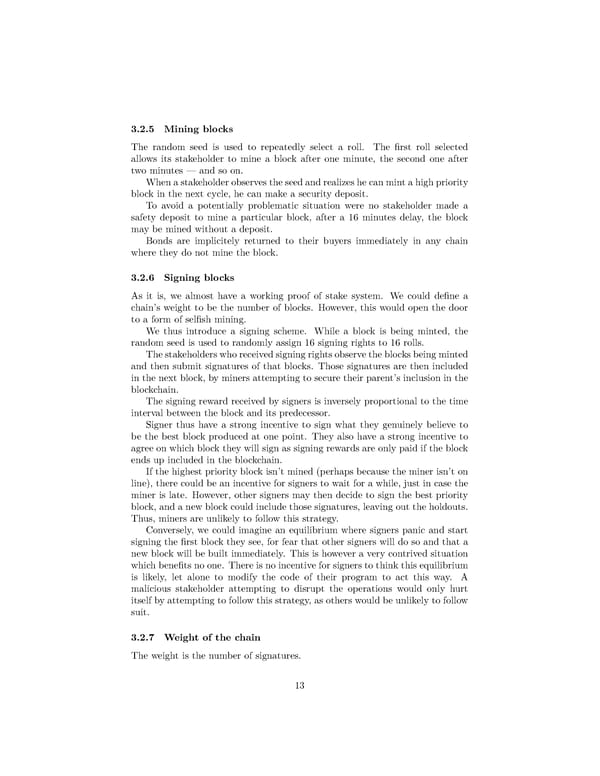3.2.5 Mining blocks The random seed is used to repeatedly select a roll. The first roll selected allows its stakeholder to mine a block after one minute, the second one after two minutes — and so on. Whenastakeholderobservestheseedandrealizeshecanmintahighpriority block in the next cycle, he can make a security deposit. To avoid a potentially problematic situation were no stakeholder made a safety deposit to mine a particular block, after a 16 minutes delay, the block may be mined without a deposit. Bonds are implicitely returned to their buyers immediately in any chain where they do not mine the block. 3.2.6 Signing blocks As it is, we almost have a working proof of stake system. We could define a chain’s weight to be the number of blocks. However, this would open the door to a form of selfish mining. We thus introduce a signing scheme. While a block is being minted, the random seed is used to randomly assign 16 signing rights to 16 rolls. Thestakeholderswhoreceivedsigningrightsobservetheblocksbeingminted and then submit signatures of that blocks. Those signatures are then included in the next block, by miners attempting to secure their parent’s inclusion in the blockchain. The signing reward received by signers is inversely proportional to the time interval between the block and its predecessor. Signer thus have a strong incentive to sign what they genuinely believe to be the best block produced at one point. They also have a strong incentive to agree on which block they will sign as signing rewards are only paid if the block ends up included in the blockchain. If the highest priority block isn’t mined (perhaps because the miner isn’t on line), there could be an incentive for signers to wait for a while, just in case the miner is late. However, other signers may then decide to sign the best priority block, and a new block could include those signatures, leaving out the holdouts. Thus, miners are unlikely to follow this strategy. Conversely, we could imagine an equilibrium where signers panic and start signing the first block they see, for fear that other signers will do so and that a new block will be built immediately. This is however a very contrived situation which benefits no one. There is no incentive for signers to think this equilibrium is likely, let alone to modify the code of their program to act this way. A malicious stakeholder attempting to disrupt the operations would only hurt itself by attempting to follow this strategy, as others would be unlikely to follow suit. 3.2.7 Weight of the chain The weight is the number of signatures. 13
 A Self-Amending Crypto-Ledger White Paper Page 14 Page 16
A Self-Amending Crypto-Ledger White Paper Page 14 Page 16